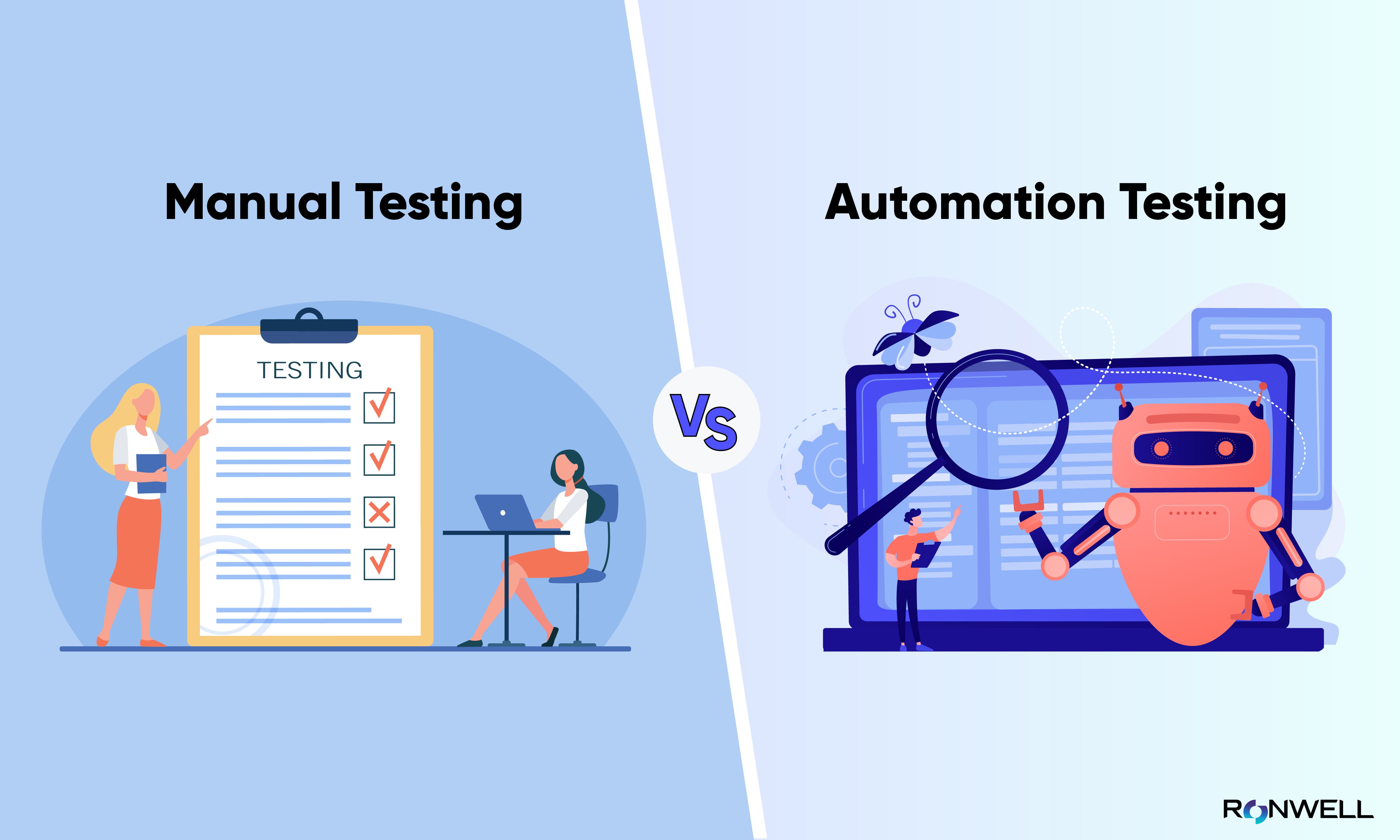

Our Services
Test Automation ServicesAI & Machine LearningBlockchainCRM ConsultingData Science & EngineeringDevOpsDigital MarketingDigital TransformationEmbedded Software DevelopmentERP Consulting ServicesManaged IT ServicesMergers & Acquisitions AdvisoryQA And Testing ServicesRobotic Process Automation SAP Consulting DevelopmentSoftware and Application DevelopmentSQL ConsultingStrategy ConsultingSustainability
- Contact Us
Our Services
- Test Automation Services
- AI & Machine Learning
- Blockchain
- CRM Consulting
- Data Science & Engineering
- DevOps
- Digital Marketing
- Digital Transformation
- Embedded Software Development
- ERP Consulting Services
- Managed IT Services
- Mergers & Acquisitions Advisory
- QA And Testing Services
- Robotic Process Automation
- SAP Consulting Development
- Software and Application Development
- SQL Consulting
- Strategy Consulting
- Sustainability
Insight
Company
Industries
- Contact Us

Manual Testing vs. Automation Testing - What is the difference?
This article helps you understand the difference between manual and automated testing and which is better for your business.
- insight
- /
- blog
- /
- manual-testing-vs-automated-testing

Automation testing has been a popular topic in the testing world. It has allowed businesses to bring innovative features to consumers more quickly while maintaining a high quality of service. Because of this, developers and quality assurance testers are now more efficient, and more tests have been run across a broader range of platforms and browsers than ever before. Manual testing, on the other hand, has kept its place.
There are many different types of testing, including black-box testing, white-box testing, system testing, system integration testing, performance testing, and load testing. It has been shown that automated testing is more effective for certain types of testing, while manual testing provides the best results for others.
Which is more effective, automatic or manual testing? Can automation testing replace manual testing? Our responses to the most frequently asked questions will make it easier for you to settle on a quality assurance strategy.
In this article, we will explain what manual and automation testing are and discuss the differences between manual and automation testing.
What Is Manual Testing?

Software tests are called "manual" if they are carried out manually by a QA analyst and are carried out to identify flaws in the working code.
As part of manual testing, the product is put through its paces to ensure that it meets all the basics. Software testers do test cases and report test results without the help of automated testing software.
Finding software flaws with this tried-and-true technique is one of the cornerstones of the testing industry. A professional tester often carries out the software testing procedure.
What Is Automation Testing?
Automated software testing involves the development of code/test scripts that carry out tests automatically. To ensure the program is reliable, testers create test scripts with the help of the right automation tools. Faster test execution is desired.
If you want to learn more about automation tools, you can read: Top 20 Automation Testing Tools 2022
In automated testing, the actual results are compared to the predicted outcomes based only on the written test conducted automatically. As a result, the tester can more accurately judge whether or not the software functions as intended.
Repetitive tasks and regression tests can be carried out automatically, eliminating the need for human testers. Though automation makes everything happen mechanically, it still needs some manual work up front to develop testing scripts.
To learn more about test automation, you can read our article: What is Automation Testing? Types, Examples, Process.
What's the Difference Between Manual vs. Automated Testing?
| Parameter | Automation testing | Manual testing |
| Definition | Automation testing is the process of testing an application or piece of software with the use of a set of automated procedures. When there are multiple releases or multiple regression cycles for an application or software, we will use automation testing. | An application's functionality is tested by a test engineer based on customer requirements. |
| Reliability | Since automation testing employs predefined tools and scripts to simulate real-world scenarios, it offers reliable testing. | Due to the risk of human error, the application can't be error-free. |
| Reusability | The script can be used more than once in different releases. | When the test case has to be performed only once or twice. |
| Batch Execution | With automation testing, it is feasible to execute many scripts in a batch at once. | It is not possible in manual testing. |
| Time-saving | The automation testing process saves time because the execution is always faster than the manual. | As a result of having to employ actual people, it takes a considerable amount of time to complete. |
| Investment | The automation tool requires a financial investment. | Investment was needed in human resources. |
| Performance testing | An automated test engineer must do performance testing to verify the application's responsiveness under simulated workloads. | Performance testing is impossible with manual testing. |
| Programming knowledge | There is no way to create the test script without knowledge of a programming language. | It is not necessary to know how to code in order to write the test case, but you should be familiar with the product. |
| Framework | The automation test engineer can speed up the process by using different frameworks, such as Data driven, Hybrid, modular-driven, and keyword-driven. | Manual testing does not require the use of a framework. |
| Operating system compatibility | Automation testing can be conducted on a variety of platforms, operating systems, and programming languages. | Manual testing cannot ensure OS compatibility since it requires a unique tester for each OS. |
| Regression testing | Automated regression tests are run by a test engineer every time there are modifications to the code for the improvement of a release. | Despite its potential use when run for the first time, the test case can fail to detect regression flaws if requirements are subject to regular change and the test engineer is not aware of this. |
When Should I Use Manual testing?
Exploratory Testing: This testing needs knowledge, experience, analytical/logical abilities, imagination, and intuition on the tester's part. Here, the test is defined by poorly written specifications and/or a short amount of time to run. In this case, we need human skills to carry out the testing process.
Usability Testing: This is where you find out if the software or product is easy to use, works well, or is convenient for the end users. In this case, human observation is essential, so it's best to do things by hand.
Ad-hoc testing: There is no set way to test in this case, and it is an unexpected way to test, and the only thing that matters is how well the tester knows the subject.
When Should I Use Automated testing?
Regression Testing: In this case, automated testing is best because the code changes often, and the regressions can be run quickly.
Load Testing: When it comes to loading testing, it is also the best way to get the testing done quickly.
Repeated Execution: The best way to test something that needs to be done more than once is to use automation.
Performance Testing: Similarly, testing that needs to simulate thousands of users simultaneously needs automation.
Can Automation Testing Replace Manual Testing?
Manual testing cannot be replaced by automation, and test automation and manual testing are both essential. Manual testing is used for complex test cases, while automated testing is used for more straightforward, more repetitive tests.
Manual testing is like walking, whereas automated testing is like driving. Getting there by car is often the quickest and most convenient choice. But there are also many times when driving a car would need to be more intelligent, efficient, and cost-effective.
To sum up, test scenarios where test automation gives better accuracy, efficiency, and cost-savings are the only ones where the advantages of automated testing over manual testing apply.
Test Automation with Ronwell Digital
Performing tests automatically is an important part of building any modern application. Even if manual testing plays a vital role, your team may save time, money, and resources by opting for automation whenever possible. A more productive feedback loop, more test coverage, and other improvements can help you bring your product to market on schedule and on budget.
It's natural to ask, "Okay, where do I even begin?" It's important to keep in mind that you can always outsource software testing if your team lacks the necessary experience in-house. At Ronwell Digital's team of experienced testers is prepared to offer a complete solution, including both manual and automated testing.
As quality assurance specialists, it is your job to make sure that the final versions of your goods provide happy customers. By automating, you can ease some of the stress. There will be better outcomes and quicker product releases as technology advances, so it's important to equip your team with the resources they need to succeed.
Interested in test automation? Contact us!
References
Triare - Automated vs Manual Testing
Beyondkey - Automation Testing vs Manual Testing
BrowserStack - Manual vs Automated Testing Differences
Software Testing Help - Manual Testing vs Automation Testing
Apica - Difference Between Automated Manual Testing
Perfecto - Automated Testing vs Manual Testing vs Continuous Testing
Writer:

Halime Yılmaz
Content Marketing Specialist
7 min read
18 November 2022, Friday
Related Posts
Related Industries








